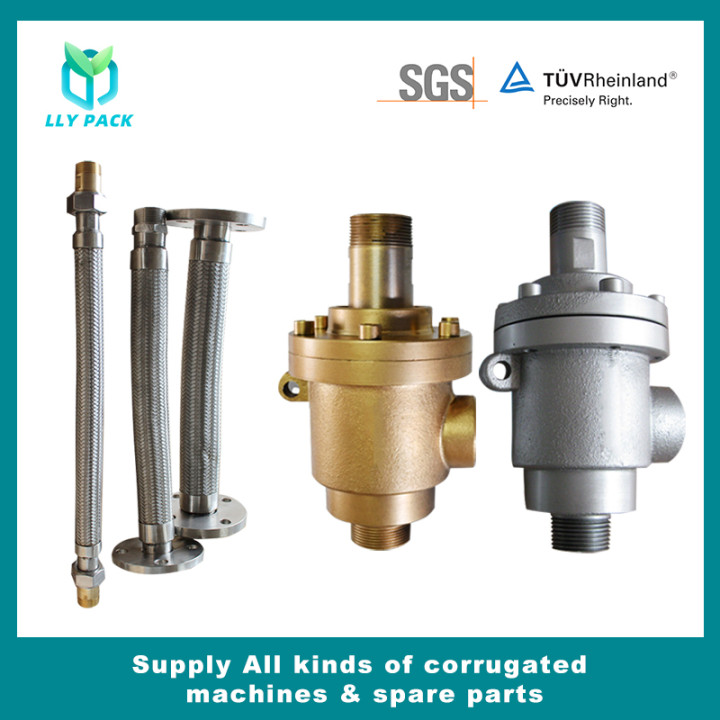Under normal circumstances, the corrugated cardboard rolled by a single-faced corrugator should meet the national standards for its height and the number of turns per 300mm length. If you use Silicon Valley as the origin of the coordinate system, the shape of the cocoon should be symmetrical, as if the alternating-current sine wave is smooth and smooth, and the cocoon height is equally lossless. However, we often encounter various forms of defects in our production practices, and the results affect the quality of corrugated cartons.
Some rickets are relatively regular, easy to analyze, and facilitate the use of appropriate improvement measures. Some deficiencies are more difficult to rule out. Chen Tingjun and other editors of the book "Corrugated carton manufacturing and equipment" and relevant packaging technical information are all well-documented studies. This article will not repeat them. However, the partial collapse of corrugated cardboard as shown in Fig. 1 is difficult to remove and takes more time. In this brief analysis, it is intended to explore the most effective ways of elimination by exploring exchanges.
First, the characteristics of local collapse of corrugated cardboard and the impact on the quality of products Corrugated cardboard local collapse features:
First, the area of collapse has changed greatly. On a per square meter basis, there are collapsed areas as small as a few square centimeters, and as many as 1,000 square centimeters.
Second, there is periodic collapse, along the production direction of the single-sided machine, cyclical but not exactly collapsed on the corrugated board;
The third is that the area of collapsing collapses along the middle of the corrugation and the middle is small, and the collapse of the dome is irregular;
Fourth, significant degumming within collapsed areas, and the local thickness of corrugated cardboard is significantly reduced, and some are only 30% of the thickness of the standard.
In mass production, the existence of such local collapse defects will affect the quality of the product, resulting in a large number of secondary waste products, resulting in a substantial increase in manufacturing costs, the company suffered. Such a three-layer, five-layer or seven-layer corrugated cardboard will inevitably produce a debonded area whose sum is greater than the national standard of 20cm2/m2, the side pressure strength is greatly reduced, the thickness of the cardboard is lower than that of the country village, and the printing pattern is indefinite, and the text is blurred. The secondary waste products seriously affect the overall quality of the carton products.
Second, the main reasons for the collapse of the collapse of this type of collapse defects often appear in the guide jaw type single-sided machine production of corrugated cardboard, the main reasons:
(1) The gap between the arc radius of the guide jaw working surface and the outer warpage of the lower corrugating roller is too large. The following corrugating roller peaks have been worn out to reduce the outside, or the lower corrugated roller roll type has undergone repeated grinding to reduce the outside diameter, and the original guide claws are still used to make the clearance too large.
(2) The installation position of the guide jaw is not proper, and the clearance between the arc of the working surface of the guide jaw and the outer diameter of the lower corrugating roll is inconsistent. If the guide jaw is not installed properly, the gap between the upper end or the lower end of the guide jaw and the lower corrugating roller is too large and is far away from the pressure roller, so that the working surface does not function as a paper guide.
(3) The guide jaws have been partially worn during use, and part of the working surface cannot guide the paper normally.
From the rational analysis, the corrugated base paper is subjected to the centrifugal force generated by the operation of the corrugating roll and the water discharged after baking, once it passes through the stress point of the tile (the upper and lower corrugated roll tooth engagement points) during the rolling process of the single-face corrugating machine. Part of the air pressure, will make the corrugated cardboard out of the corrugated roll surface, then rely mainly on the guide jaws to hold the corrugated paper tightly, making it tightly attached to the surface of the lower corrugating roller operation.
If the gap between the arc radius of the guide jaw working face and the outer diameter of the lower corrugating roller is too large or inconsistent (except for the glue application), the paper guiding function cannot be properly performed and the corrugated paper will be free in the radial direction. State, from the corrugated roll peak surface, resulting in 楞-shaped peak-valley dislocation, when the corrugated roll and pressure roller compaction in operation, the misaligned corrugated paper roll shape is squeezed by the lower corrugated roll peak, making corrugated paper has been coated with glue The peaks are irregularly bonded to the inner (clip) paper to form a local collapse of the single-sided corrugated cardboard. Therefore, in the case of normal corrugating roller, to solve the local collapse of corrugated cardboard, the key is to make the gap between the guide jaw working face and the outer diameter of the lower corrugating roller reasonable and consistent.
Third, the method of queuing collapsing First, we must measure or inspect whether the arc radius of the guide jaw working face is matched with the outer diameter of the lower corrugating roller. If there is local abnormal wear or wear on the working surface of the guide jaw, the guide jaw should be replaced immediately. When the corrugation type of the lower corrugating roller undergoes repeated grinding and the outer diameter decreases or the peak of the lower corrugating roll significantly wears to reduce the outer diameter, the arc radius of the working surface of the guide jaw is reworked according to the reduction in the outer diameter of the lower corrugating roll. In practice, we realized the preparation of the guide jaw radius: guide claw working surface arc radius = the actual diameter of the lower corrugated roller ÷ 2+ (1.5-1.9) × corrugated paper thickness, which E-type draw 1.5, B-type draw 1.6 , C-type picking 1.8, A-type picking 1.9, in order to facilitate the wedging guide, the radius of the arc 10-20mm above the guide surface, plus an additional 0.2 to 0.4mm.
Followed by the appropriate installation position of the guide jaws, the matching gap between the arc radius of the guide jaw working surface and the outer diameter of the lower corrugated roll should be controlled according to the 楞 type Wang Tong (1.5-1.9) × corrugated base paper thickness, and to adjust to the upper and lower gap Consistently, the plane of the guide jaws should be kept perpendicular to the axis of the lower corrugating roller.
The second is to check whether the two ends of the guide jaws are appropriate. If there are any errors, they should be adjusted, ground or remanufactured. Corrugated rollers and guide jaws have adhered materials on the work surface, which will also affect normal paper guides and should be promptly cleaned. Also need to eliminate the corrugated roller between the Wang parallel, the temperature is insufficient, corrugated paper moisture and other factors. Proficient in the above methods, take appropriate measures, collapse defects can be avoided or successfully eliminated.










